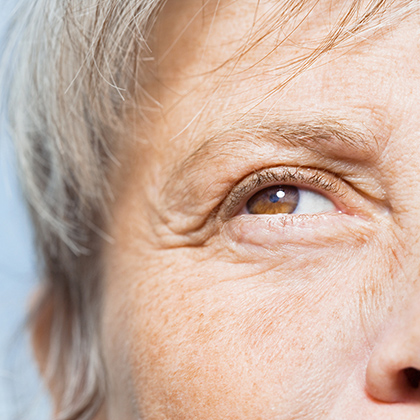
Cataracts are a common eye condition: especially the type that comes from getting older. According to Patient, age-related cataracts are thought to affect around half of people aged 65 or older and 70 per cent of those aged over 85.i
Cataracts are easily and routinely treated in the UK. However, the World Health Organization claims people in many countries have no access to cataract surgery. As a result, about 20 million throughout the world are blind because of cataracts.ii
So what is a cataract exactly? It starts with a gradual change inside the lens in your eye (typically both eyes are affected, with one eye usually worse than the other). Normally your lenses – which are made of water and proteins – are clear. But some of the proteins can start to clump together, making parts of the lens cloudy.
Since your lens focuses light onto the back of your eye (the retina), allowing you to see what’s around you, your vision can become less clear when parts of it become cloudy. This happens because the clouded areas block some of the light from reaching the retina.

If your lens only has a few, very small areas of cloudiness, your vision may not be affected that much. But these cloudy areas often worsen, and over time your eyesight could begin to deteriorate. If left untreated, in time a cataract can cause complete loss of vision in the affected eye.
Thankfully cataract-related blindness is incredibly rare in the UK. However, knowing the signs can still be very useful. By spotting a cataract early, you can take the necessary steps to prevent it from seriously affecting your vision. This guide will help you understand the different types of cataracts, and how to spot problem signs as early as possible.
Cataract types: what you should know
The most common type of cataract by far is the age-related cataract (also sometimes called a senile cataract). According to the RNIB, developing cataracts is a normal part of growing older, with most starting to develop cataracts after the age of 65 (though some in their 40s and 50s can also develop them).iii
This type of cataract usually takes years to form, and many people don't realise they are affected at first. According to Patient, in some cases, cataracts will never affect vision, though for most people cataract-related vision problems can gradually worsen over time.iv
Congenital cataracts, on the other hand, are cataracts that are present when a baby is born – though they aren’t common. These are routinely checked for at birth and when a baby is six to eight weeks old.
However, with the most common type of cataract, some factors may increase your chances of developing them, such as:
-
Poor diet (according to the American Optometric Association, though results are inconclusive, studies suggest an association between cataract formation and low levels of nutrients called antioxidants)v
-
Smoking
-
Excessive alcohol drinking
-
Family history of cataracts
-
Diabetes (people with diabetes often develop cataracts early)
-
Excessive unprotected sunlight exposure (UV)
-
Obesity
-
High blood pressure
-
Eye surgery, injury or trauma
-
Overuse of hormone replacement therapy (HRT)
-
Overuse of steroid eye drops
-
Certain medications (steroids, for example)
-
Upper body radiation treatments
-
Severe short-sightedness
Having another eye condition may also increase your risk of cataracts, including retinitis pigmentosis, a largely inherited condition that affects and eventually kills the cells in your retina; uveitis (inflammation of the middle part of the eye called the uvea); and glaucoma. These are sometimes referred to as secondary cataracts. Glaucoma can also cause symptoms similar to cataracts, as can another eye condition called age-related macular degeneration.
Cataracts are often classified according to how they are formed:
-
Nuclear cataracts form deep within the central part of the lens, typically changing the lens from clear to yellow and sometimes brown (these are usually the type associated with ageing).
-
Subcapsular cataracts develop at the back of the lens and often affects people with diabetes or those taking steroid tablets. These are also referred to as posterior capsular cataracts.
-
Cortical cataracts start developing at the outer edges of the lens and gradually spread towards the centre.
What should you look out for?
Knowing the signs to look out for can help, as your cataract could be treated before it can seriously affect your vision. At first, all you may notice is your vision starting to get blurry – it may look similar to having a smear on your glasses. You may also start to experience one or more of the following:
-
Spots in your vision
-
Halos around bright lights
-
Faded or washed-out colours
-
Poor vision in bright sunlight or brightly lit rooms
-
Poor night vision
-
Increased sensitivity to bright lights (car headlights, for instance, may glare more than before)
-
Double vision
If you’ve been affected by any of the above, it’s time to book an appointment to see your optician. An eye specialist can offer reassurance and explain how to treat your cataracts. They may explain that recognising early signs could help slow down or reduce the development of cataracts.
How are cataracts treated?
The good news is that most cataracts are easily diagnosed by a doctor or optician. They can be spotted during your regular eye test, for example. Once diagnosed, you may be offered cataract surgery, which is currently the only medical treatment available.
If a cataract isn’t particularly affecting your vision, your doctor or optician may advise you to wait before having surgery – most people opt to have their cataract treated when it starts affecting their ability to read, watch TV, or drive.
The operation is straightforward, with very little risk. Plus, with around 400,000 cataract operations performed in the UK each year,vi it’s one of the most routine surgical procedures.
The operation removes the natural cloudy lens and replaces it with an artificial one: called an intraocular lens (IOL). The procedure – which usually takes between 10 and 20 minutes – is usually performed under local anaesthetic, and most people don’t have to stay in hospital overnight. Most importantly, once the new lens is inserted, your vision will be clear again.
There may, however, be ways you can help yourself to prevent the need for surgery. Things like your diet, weight, whether you smoke, how much alcohol you drink, and how much sun exposure, can affect your risk for cataracts. Ensuring your lifestyle is as healthy as possible can help slow down the progression of cataracts, and can even stop them from developing in the first place.
We explore these self-help measures in our article Preventing Cataracts Practical Steps to Maintain Eye Health – why not take a look?
There’s also lots more advice and information on how your lifestyle could help keep your vision as healthy as possible in the rest of our Vision Health Hub articles.
References:
-
Lowth, M. (2015). Cataracts and Cataract Surgery. Available online: https://patient.info/doctor/cataracts-and-cataract-surgery
-
World Health Organisation [WHO]. Priority Eye Diseases. (2016). Available online: https://www.who.int/blindness/causes/priority/en/index1.html
-
Royal National Instutite of Blind People [RNIB]. (2016). Available online: https://www.rnib.org.uk/sites/default/files/2019_Understanding_Cataracts_2.pdf
-
Lowth, M. (2018). Cataracts. Available online: https://patient.info/health/visual-problems/cataracts
-
American Optometric Association [AOA]. (2016). Available online: https://www.aoa.org/patients-and-public/eye-and-vision-problems/glossary-of-eye-and-vision-conditions/cataract
-
The Royal College Of Ophthalmologists [RCOPHTH]. Available online: https://www.rcophth.ac.uk/wp-content/uploads/2015/10/RCOphth-The-Way-Forward-Cataract-300117.pdf
Related Posts?
Disclaimer: The information presented by Nature's Best is for informational purposes only. It is based on scientific studies (human, animal, or in vitro), clinical experience, or traditional usage as cited in each article. The results reported may not necessarily occur in all individuals. Self-treatment is not recommended for life-threatening conditions that require medical treatment under a doctor's care. For many of the conditions discussed, treatment with prescription or over the counter medication is also available. Consult your doctor, practitioner, and/or pharmacist for any health problem and before using any supplements or before making any changes in prescribed medications.

Christine
Christine Morgan has been a freelance health and wellbeing journalist for almost 20 years, having written for numerous publications including the Daily Mirror, S Magazine, Top Sante, Healthy, Woman & Home, Zest, Allergy, Healthy Times and Pregnancy & Birth; she has also edited several titles such as Women’ Health, Shine’s Real Health & Beauty and All About Health.
View More



